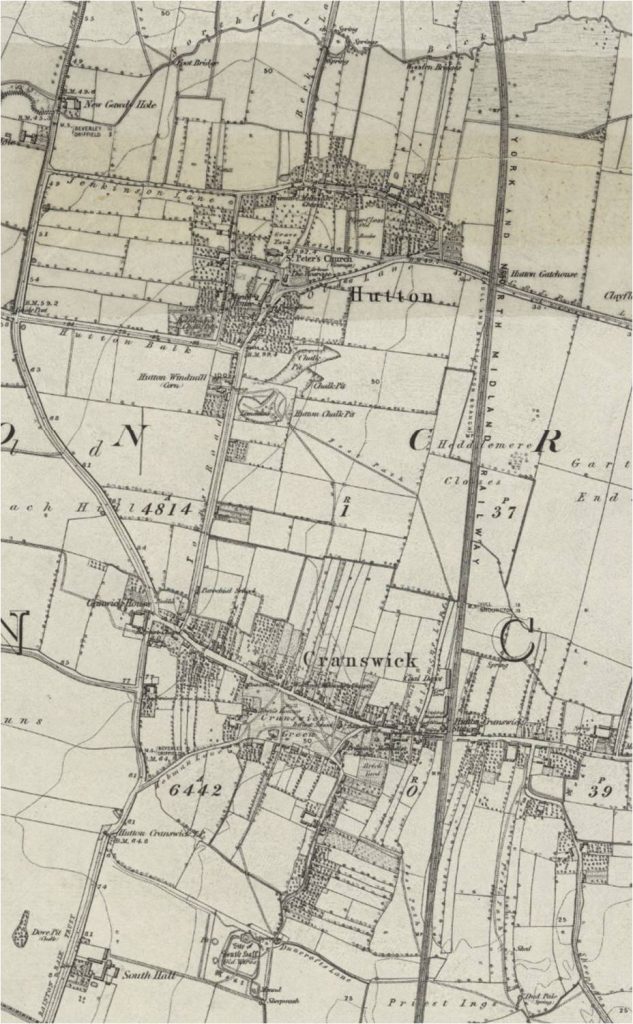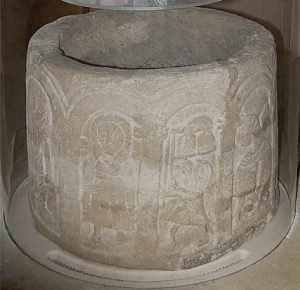
The parish of Hutton Cranswick is situated in what was once the wapentake of Harthill (Bainton Beacon division), part of the historical East Riding of Yorkshire (see maps in Introduction). Its boundaries remained unchanged after the 1832 boundary changes, so that the parish still includes the sub-parishes and localities of Corps Landing, Ganwick, Rotsea and Sunderlandwick.
Parts of Hutton and Cranswick were considered a single entity as early as the Domesday survey, when they were in the hands of Cnut, son of Karli, Edwulf and Northmann. By 1086 Count Robert of Mortain was tenant in chief and Nigel Fossard lord of this entity. However, there were parcels of land situated in both Hutton and Cranswick that were considered separately. Gamal, son of Karli, is shown as lord of land in Hutton in 1066 with Hugh, son of Baldric, as tenant in chief and lord 1086, while Earl Morcar is shown as lord of land in Cranswick in 1066 with King William as tenant in chief and lord in 1086. By the time parish registers were introduced the two villages had officially merged to form a single parish, though the records continued to specify the dwelling place of each person until at least the end of the 19th century. The two manors also remained distinct and the villages maintained their own characters, still being referred to by their original names to this day.
Hutton is situated on higher ground than its twin, as illustrated by its name which derives from Old English: hōh (ridge, spur) + tūn (enclosure; settlement, town). It is a place of considerable antiquity, with traces of a fortified camp apparently still visible within its limits, and its surrounding area was the site of many battles between the Saxons and Danes. By the 13th century Hutton was in the hands of the Mauley family. It subsequently passed through various hands, until it came into the possession of Lord Hotham, whose brick manor house and farm still stand near the church.
Cranswick is situated in a dip to the south of Hutton round a spacious green, where water is abundant. Its name is also derived from Old English: cran (crane) + s (denoting the genitive case) + wīċ (village). In the latter part of the 18th century the estate was purchased by Mr. Denison, from whom it eventually descended to the Earl of Londesborough. The manor house, formerly occupied by Lord Londesborough, is situated at the top of the village. To the east of the village, at the junction of Stockbridge Lane and Sheepman Lane, lie the remains of a moat of a 13th century Cistercian grange which was attached to Meaux Abbey. Several mansions were also built in Cranswick but they have since disappeared, though the remains of the moat around South Hall can be seen on old maps. Its newer incarnation, built on Beverley Road to the west of the original, is now surrounded by an industrial estate.
 Google Maps |  2007 |  © JThomas, 2023 |  © Marathon, 2024 |
The church of Hutton Cranswick is situated in Hutton and is dedicated to St. Peter. It occupies the site of an Anglo-Saxon church that was dedicated to St. Andrew. In 1303 the church was given to the prior and convent of Watton, who were given permission to abolish the office of rector and to replace it with a vicar, to be appointed by the same and also paid and housed by them. The first vicarage consisted of a house, garden and croft situated next to the church. It was replaced in 1874 by a handsome brick building in the Gothic style, a gift from Lord Hotham, into whose family it had passed in the mid 1600s. The church building we see today retains traces of the Norman, Transition and Early English styles, reflecting the periods when restoration and alterations took place. It consists of a two bay chancel with a north vestry, a four bay aisled nave with pointed arches, a transept, a 19th century south porch which retains its ancient Norman zigzag mouldings and a massive pinnacled western tower containing three bells. In 1875-6 the whole fabric of the church was thoroughly restored with the exception of the tower. The nave and chancel were re-roofed, an organ chamber added on the north side of the chancel and the high-backed box pews removed to make way for more modern ones. A new font was made to replace the Saxon one with its curious carvings (now held by the York Museum, though currently on loan to the Hull and East Riding Museum), but remains of an ancient roodscreen are still visible.
 right: St. Peter's church tower, 2007 |  |  right: St. Peter's church, Saxon font |  |
Corps Landing is the name given to a farm standing at the eastern extremity of the parish on a meander of the river Hull. One school of thought suggests that its name is derived from Old Norse: korp (raven) + land (land) + eng (meadow). This is in keeping with the invasion of the area by the Danes, who are known to have sailed up the Humber estuary into which the river Hull flows.
Ganwick or Gannock was a farm in the parish of Hutton Cranswick but it has either been renamed or is no longer standing.
Rotsea is also situated in the eastern extremities of the parish on the plain over which the river Hull meanders. In the Middle Ages it formed part of the fee of the Brus family. It even had its own chapel, dedicated to St. Andrew and built in the early 1300s, but by the late 1400s it had either fallen into disuse or had disappeared entirely. A branch of the Thweng family later held lands and resided there, and in the mid 1800s the Sykes, Hotham and Holtby families were the principal landholders, the latter family occupying the manor house. Around the same time three Ancient British urns were found in a gravel pit; they are now held by the York Museum.


Sunderlandwick was recorded in Domesday as belonging to Siward and Vifli in 1066, but it is now classified as a deserted medieval village, earthworks being all that remain of the former settlement. In 1892 a mound called How Hill was excavated which provided evidence that the area had been settled since ancient times. The excavations revealed a Bronze Age round barrow, 23m in diameter, where flint articles, burnt bones and a food vessel were found, indicating a burial site. As the top of the mound is flat, it is thought that it might later have been used as a moot hill, an assembly or meeting place. Sunderlandwick Hall, lying to the north-east of the medieval village and How Hill, was built in the late Georgian style by the Reynard family, the principal landowners. It was destroyed by fire in 1945 but Sunderlandwick House rose from its ashes in 1962-3, built for Sir Thomas Ferens.
Members of both the Pickering and the Puckering families are recorded as living in Hutton and Cranswick.
Master Robert de Pykering was the last rector of the church of Hutton. Though a member of the Brus family (9th generation), once ordained, he took the name of his place of ordination. Robert was presented as rector in 1295, but in 1303 the prior and convent of Watton petitioned his elder brother Master William de Pickering, Archdeacon of Nottingham, to be given the church and to replace the rector with a vicar. Robert resigned his rectorship in the same year, but would go on to occupy many positions of authority, such as the King of England’s envoy to the King of France and Dean of York, culminating in the office of Archdeacon of Nottingham, following his brother’s death.
William of the 20th generation of the Pickerings of Holderness was born in 1684, the 9th child of John who had set up shop as a shoemaker in Rise. Seeking work as a labourer, William arrived in Cranswick in the early 1700s, he married his three wives at St. Peter’s and had thirteen children. All his surviving sons moved away from Hutton Cranswick. The first son John, a bricklayer, founded the Pickerings of Lincolnshire, while the others remained in the East Riding. The second son William, also a bricklayer, subsequently moved to Preston, as did the third son Daniel. The fourth son David went to Skirlaugh, but fifth son George did not survive infancy and was buried in the parish. The two younger sons followed the trend set by the elder ones: Robert going to Kilnwick, and Richard to Bridlington.
When Thomas of the Puckerings of Driffield arrived in Driffield in the late 1700s, he and his children were recorded as Pickerings, but his grandson, also Thomas of the 12th generation, was recorded as Puckering, as were his children. Of the latter, his first surviving son Robert moved to Hutton Cranswick permanently, two other sons emigrated to the colonies, while the rest of his siblings and cousins remained in Yorkshire.
Mary Puckering of the 10th generation of the Puckerings of Flamborough was originally from Bridlington, but her three sons were baptised at Hutton Cranswick church. The eldest, George Brown settled in the village and had children there, his son John becoming the local carrier. However, his two younger brothers Boaz and Timothy were both convicted of sheep stealing, each receiving a life sentence, and were transported to Australia.
Sources:
Hutton Cranswick, Corps Landing and Rotsea:
https://www.genuki.org.uk/big/eng/YKS/ERY/HuttonCranswick
https://intel-hub.eastriding.gov.uk/parish-profile/#/view-report/bd6a0cb7f85a46998f874a42bfd0dc8e/PP079
https://en.wikipedia.org/wiki/Hutton_Cranswick
https://opendomesday.org/place/TA0252/cranswick
https://opendomesday.org/place/TA0253/hutton-cranswick
https://en.wiktionary.org/wiki/Hutton
https://en.wiktionary.org/wiki/Cranswick
Old Norse Dictionary: https://www.vikingsofbjornstad.com/Old_Norse_Dictionary_N2E.shtm
History and Topography of Yorkshire, York, Ainsty, East Riding, vol. 2, pp. 505-7: https://books.google.fr/books/about/History_and_topography_of_the_city_of_Yo.html?id=3cEHAAAAQAAJ
A Tale of Two Villages: Hutton and Cranswick
Bulmer’s History, Topography and Directory of East Yorkshire with Hull 1892, pp. 215-218: https://specialcollections.le.ac.uk/digital/collection/p16445coll4/id/324025
Kelly’s Directory of the North and East Ridings of Yorkshire 1893, p.449: https://specialcollections.le.ac.uk/digital/collection/p16445coll4/id/290173
Kelly’s Directory of the North and East Ridings of Yorkshire 1913, p.562: https://specialcollections.le.ac.uk/digital/collection/p16445coll4/id/75995
Hutton Cranswick Village website: https://www.huttoncranswick.com
Church of St. Peter: https://historicengland.org.uk/listing/the-list/list-entry/1161006?section=official-list-entry
Register of Thomas of Corbridge vol. 1, pp.178 and 195: https://archive.org/details/corbridgeregister01/page/n191
St. Andrew’s Saxon font: https://www.crsbi.ac.uk/view-item?i=15610, https://greatenglishchurches.co.uk/html/north_east_yorks_group_of_norman_fonts.html
St. Peter’s Norman south porch: https://www.crsbi.ac.uk/view-item?i=10903
Sunderlandwick:
https://en.wikipedia.org/wiki/Sunderlandwick
https://opendomesday.org/place/TA0154/old-sunderlandwick
Deserted village: https://www.heritagegateway.org.uk/Gateway/Results_Single.aspx?uid=79336&resourceID=19191
Bronze Age barrow: https://www.heritagegateway.org.uk/Gateway/Results_Single.aspx?uid=79286&resourceID=19191
Sunderlandwick Hall: http://www.lostheritage.org.uk/houses/lh_yorkshire_sunderlandwickhall_info_gallery.html
Sunderlandwick House: https://historicengland.org.uk/listing/the-list/list-entry/1375668?section=official-list-entry
